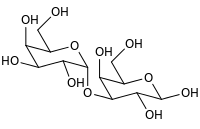Galactose-alpha-1,3-galactose
Galactose-alpha-1,3-galactose, commonly known as alpha gal and the Galili antigen, is a carbohydrate found in most mammalian cell membranes. It is not found in primates, including humans, who have lost the GGTA1 gene. Their immune systems recognize it as a foreign body and produce xenoreactive immunoglobulin M antibodies, leading to organ rejection after transplantation.[1]
 | |
| Names | |
|---|---|
| Systematic IUPAC name
3-O-α-D-Galactopyranosyl-D-galactopyranose | |
| Other names
Alpha-gal; 3-α-Galactobiose; Gal(α1-3)Gal; alpha-D-Gal-(1→3)-D-Gal | |
| Identifiers | |
CAS Number |
|
3D model (JSmol) |
|
| ChemSpider | |
PubChem CID |
|
| UNII | |
InChI
| |
SMILES
| |
| Properties | |
Chemical formula |
C12H22O11 |
| Molar mass | 342.297 g·mol−1 |
Except where otherwise noted, data are given for materials in their standard state (at 25 °C [77 °F], 100 kPa). | |
| Infobox references | |
Anti-alpha gal immunoglobulin G antibodies are some of the most common in humans. Regular stimulation from gut flora, typically initiated within the first six months of life, leads to an exceptionally high titre of around 1% of all circulating IgG.[2] Alpha gal has also been suggested to play a role in an IgE-specific allergic response to some meats.[3] While this allergic response is quite well documented, there is significant discrepancy between laboratory tests and clinical findings, indicating that much research must still be done on the alpha gal mechanism of action and related tests.[4] Recent studies are showing increasing evidence that this allergy may be induced by the bite of the lone star tick (Amblyomma americanum)[5][6] in North America and the castor bean tick (Ixodes ricinus) in Sweden.[7]
A bacterial alpha-galactosidase that efficiently removes linear alpha-gal ends from molecules has been identified. It could be useful for xenotransplantation in the future.[8] Human reaction to alpha-gal has beneficial uses as a vaccine adjuvant and for enhancing wound healing.[9][10]
See also
- Alpha-gal allergy
- Galactose
References
- Cowan PJ, Aminian A, Barlow H, Brown AA, Chen CG, Fisicaro N, Francis DM, Goodman DJ, Han W, Kurek M, Nottle MB, Pearse MJ, Salvaris E, Shinkel TA, Stainsby GV, Stewart AB, d'Apice AJ (June 2000). "Renal xenografts from triple-transgenic pigs are not hyperacutely rejected but cause coagulopathy in non-immunosuppressed baboons". Transplantation. 69 (12): 2504–15. doi:10.1097/00007890-200006270-00008. PMID 10910270.
- Macher, BA; Galili, U (February 2008). "The Galalpha1,3Galbeta1,4GlcNAc-R (alpha-Gal) epitope: a carbohydrate of unique evolution and clinical relevance". Biochimica et Biophysica Acta. 1780 (2): 75–88. doi:10.1016/j.bbagen.2007.11.003. PMC 2271034. PMID 18047841.
- Williams L (December 27, 2013). "Just one bite". Sydney Morning Herald. Australia. p. 20.
- Krishna, Neal; Krishna, S.; Krishna, R. (November 2017). "P112 Correlation between clinical findings and laboratory tests for alpha gal sensitivity". Annals of Allergy, Asthma & Immunology. 119 (5): S37. doi:10.1016/j.anai.2017.08.136. ISSN 1081-1206.
- Crispell, Gary; Commins, Scott P.; Archer-Hartman, Stephanie A.; Choudhary, Shailesh; Dharmarajan, Guha; Azadi, Parastoo; Karim, Shahid (17 May 2019). "Discovery of Alpha-Gal-Containing Antigens in North American Tick Species Believed to Induce Red Meat Allergy". Frontiers in Immunology. 10: 1056. doi:10.3389/fimmu.2019.01056. PMC 6533943. PMID 31156631.
- "Bad bite: Doctors see surge of sudden meat allergies caused by ticks that are spreading in US" USNews, July 7, 2014
- Hamsten C, Starkhammar M, Tran TA, Johansson M, Bengtsson U, Ahlén G, Sällberg M, Grönlund H, van Hage M (April 2013). "Identification of galactose-α-1,3-galactose in the gastrointestinal tract of the tick Ixodes ricinus; possible relationship with red meat allergy". Allergy. 68 (4): 549–52. doi:10.1111/all.12128. PMID 23414348.
- Liu, QP; Yuan, H; Bennett, EP; Levery, SB; Nudelman, E; Spence, J; Pietz, G; Saunders, K; White, T; Olsson, ML; Henrissat, B; Sulzenbacher, G; Clausen, H (28 March 2008). "Identification of a GH110 subfamily of alpha 1,3-galactosidases: novel enzymes for removal of the alpha 3Gal xenotransplantation antigen". The Journal of Biological Chemistry. 283 (13): 8545–54. doi:10.1074/jbc.M709020200. PMC 2417185. PMID 18227066.
- Galili, U (September 2013). "Anti-Gal: an abundant human natural antibody of multiple pathogeneses and clinical benefits". Immunology. 140 (1): 1–11. doi:10.1111/imm.12110. PMC 3809700. PMID 23578170.
- Mandell RB, Flick R, Staplin WR, Kaniewski LD, Carzoli AK, Manuszak RP, Wang J, Rossi GR, Vahanian NN, Link CJ (August 2009). "The αGal HyperAcute(®) Technology: enhancing immunogenicity of antiviral vaccines by exploiting the natural αGal-mediated zoonotic blockade". Zoonoses and Public Health. 56 (6–7): 391–406. doi:10.1111/j.1863-2378.2008.01191.x. PMID 19486321.